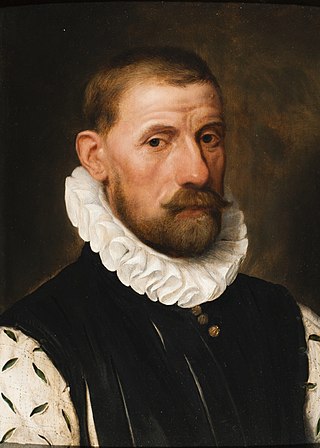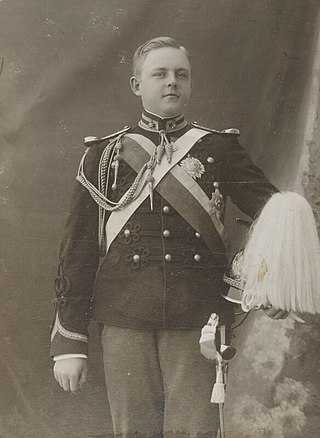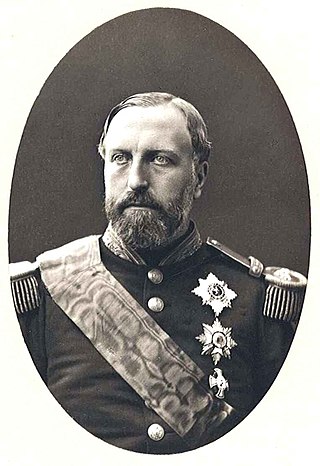
Ferdinand VII was a King of Spain during the early 19th century. He reigned briefly in 1808 and then again from 1813 to his death in 1833. He was known to his supporters as el Deseado and to his detractors as el ReyFelón.

Lamoral, Count of Egmont, Prince of Gavere was a general and statesman in the Spanish Netherlands just before the start of the Eighty Years' War, whose execution helped spark the national uprising that eventually led to the independence of the Netherlands.

Prince Miguel Januário of Braganza was the Miguelist claimant to the throne of Portugal from 1866 to 1920. He used the title Duke of Braganza.

The Distinguished Order of the Golden Fleece is a Catholic order of chivalry founded in Bruges by Philip the Good, Duke of Burgundy, in 1430, to celebrate his marriage to Isabella of Portugal. Today, two branches of the order exist, namely the Spanish and the Austrian Fleece; the current grand masters are King Felipe VI of Spain and Karl von Habsburg, head of the House of Habsburg-Lorraine, respectively. The Grand Chaplain of the Austrian branch is Cardinal Christoph Schönborn, Archbishop of Vienna.

Dom Luís Filipe, Prince Royal of Portugal, Duke of Braganza, was the eldest son and heir-apparent of King Carlos I of Portugal. He was born in 1887 when his father was still Prince Royal of Portugal and received the usual style of the heirs to the heir of the Portuguese crown: 4th Prince of Beira at birth, with the subsidiary title 14th Duke of Barcelos. After his grandfather King Luís I of Portugal died, he became Prince Royal of Portugal with the subsidiary titles 21st Duke of Braganza, 20th Marquis of Vila Viçosa, 28th count of Barcelos, 25th count of Ourém, 23rd count of Arraiolos and 22nd count of Neiva.

Ramón María Narváez y Campos, 1st Duke of Valencia was a Spanish general and statesman who served as Prime Minister on several occasions during the reign of Isabella II. He was also known in Spain as El Espadón de Loja, "The Big Sword of Loja".

Prince Philippe of Belgium, Count of Flanders, was the third born and second surviving son of King Leopold I of Belgium and Louise d'Orléans. He was the brother of Leopold II of Belgium and Empress Carlota of Mexico.

Duke of Medinaceli is an hereditary title in the peerage of Spain, accompanied by the dignity of Grandee. The Catholic Monarchs, Ferdinand II of Aragon and Isabella I of Castile, created the title and awarded it on 31 October 1479 to Luis de la Cerda y de la Vega. He also held the title of 5th Count of Medinaceli, which was first awarded in 1368 to his ancestor, Bernal de Foix.

Claude Lamoral, 3rd Prince of Ligne, Prince of Epinoy, Marquis of Roubaix and Count of Fauquemberg, was a nobleman from the Spanish Netherlands, a soldier and diplomat in the service of Philip IV of Spain and Charles II of Spain.
The Sicilian title Duke of Bivona stems from the middle 16th century. Bivona is in Sicily, which had been conquered by Peter III of Aragon in 1282. It was given to people related to the powerful medieval Aragonese family of Luna, Zaragoza.

José Miguel de Carvajal-Vargas y Manrique de Lara Polanco, 2nd Duke of San Carlos,, 6th conde de Castillejo and 9th conde del Puerto was an Absolutist military and noble. A favourite of Ferdinand VII of Spain, he became his Mayordomo mayor and Secretario de Estado.

Alexander von Bournonville, Alexander de Bournonville, Alexander II Hyppolite, Prince of Bournonville and third Count of Hénin-Liétard was a Flemish military commander. He held the titles of Field Marshal of the Holy Roman Empire, Knight of the Order of the Golden Fleece, Viceroy of Catalonia (1678–1685) and Viceroy of Navarre (1686–1691).

Anne-Adrien-Pierre de Montmorency, 1st Duke of San Fernando Luis, 3rd Duke of Laval-Montmorency, GE, was a peer of France and of Spain.

Francisco V Fernández de la Cueva y Fernández de la Cueva, was the 10th Duke of Alburquerque, a Grandee of Spain, a Knight of the Order of the Golden Fleece from 1707, and Viceroy of New Spain from 27 November 1702 to 14 January 1711. He was viceroy during the War of Spanish Succession and his tenure as Viceroy of New Spain is commemorated in the namesake of Albuquerque, New Mexico.

The House of Zúñiga is a Spanish noble lineage who took their name from their domain. Various members of the family were distinguished in the service of the Spanish crown in Europe and the Americas as viceroys, governors, military, diplomats, writers and members of religious orders. Charles I of Spain in 1530 named two members of the family, the Duke of Béjar and Plasencia and the Count of Miranda del Castañar, among his Immemorial Grandees, while eight members of the family were inducted into the Order of the Golden Fleece.

Jean de Villiers, Seigneur of L'Isle-Adam was a French nobleman and military commander who fought in the Hundred Years' War. As a supporter of the Duke of Burgundy, he fought on both sides of the conflict – English and French. He was a Marshal of France and a founding member of the knightly Order of the Golden Fleece.

Guillaume de Melun (1588–1635) was a nobleman in the Spanish Netherlands, Governor and Grand Bailiff of the County of Hainaut, and Constable of Flanders, who conspired against the government.















